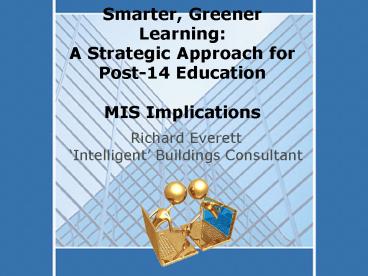Richard Everett - PowerPoint PPT Presentation
1 / 29
Title:
Richard Everett
Description:
... more integrated building allows communications between staff to be considerably enhanced. ... ID Cards systems (Access) Wireless ! Etc etc =IP. Post Script ' ... – PowerPoint PPT presentation
Number of Views:25
Avg rating:3.0/5.0
Title: Richard Everett
1
Richard EverettIntelligent Buildings Consultant
Smarter, Greener Learning A Strategic Approach
for Post-14 Education MIS Implications
2
Green and Intelligent Buildings save costs and
boost productivity, sustainably! So where does
MIS fit in?
Ask not what can you do for your technology?
ask what can your technology do for you? with
apologies to John F Kennedy
3
Intelligent Building Definition
- Intelligent buildings should be sustainable,
healthy, technologically aware, meet the needs of
occupants and business and should be flexible and
adaptable to deal with change - Clements-Croome (2007)
4
Definition - 2
- An intelligent building is a dynamic and
responsive architecture that provides every
occupant with productive, cost effective and
environmentally approved conditions through a
continuous interaction among its four basic
elements places (fabric structure facilities)
processes (automation control systems) people
(services users) and management (maintenance
performance) and the interrelation between them. - The CIB Working Group W098 (1995).
5
Behaviours
- Tidy or untidy
- Methodical or haphazard
- Good memory or Forgetful
- Lighting, heating and systems
- consume energy
- control them
- Automation switch it off!
6
The ideal
7
intelligent
Unified messaging
Cause and effect
Library systems
Building Mgmt Systems
Learning technology
Smart cards
Infrastructure
iB
Trend analysis
Wireless
AV
mLearning
Digital signage
IP telephony
Room management
Cashless catering
Buildings
Thin client Blade PCs
8
The goal 4 Es
e
- Economy minimising cost
- Efficiency making best use of resources
- Effectiveness degree of achievement of outcome
- Efficacy degree of relevance of outcome.
e
e
e
9
Pedagogy
- Worker Performance
- Motivation x Ability x Opportunity
- Tasks - Individuals
- Want to do
- Capable of doing
- Can be done
- Building creates
- Physical environment.
10
Pedagogy and Buildings
- Space has the power to condition behaviour and
form personality. ... The environment affects our
emotions, feelings and reactions. - Scuri (1995)
- the more integrated building allows
communications between staff to be considerably
enhanced. - Penn et al. (1977)
11
Colours
- Energises, activates emotion, increases blood
pressure - Touches deep seated emotions, releases traumas,
induces peace and harmony - Calms, heals, sense of integrity
- Uplifts emotionally, mentally and spiritually.
12
CLCs the new LRCs
- communications
- social interaction
- flexibility
- hierarchical and non-hierarchical organisational
structures - work productivity
- effectiveness of ventilation and air quality
- privacy
- crowding
- individual control
- Storage.
- Ilozor (2000)
13
Happy workers are effective
- research suggests a correlation between worker
productivity, wellbeing, environmental, social
and organisational factors. - Clements-Croome (2007)
14
Return on Investment
- 25
Salary exceeds building energy and maintenance
costs and annual construction rental cost by a
factor of
15
Salary costs as a percentage of total
organisational costs
- 90
16
Ratio of costs Construction Maintenance
Operating Business operating
- 1 5 200
17
Annualised UK building costs
- Capital investment
- 200/m² per year
- Energy and plant costs
- 10/m² per year
- Staff costs
- 15,000/m² per year
- Hodgett (1993)
- So a 1 change in productivity??
18
Sydney Opera House
Cost 120m
Cost overrun 1700
Replacement Cost 100m
19
Energy usage (of all energy)
- Energy used to heat, light and ventilate
buildings - 45
- Energy used to construct buildings
- 5
- Edwards (2002)
20
Carbon Trust
- High potential
- Building Controls
- Smart metering
- Building fabric
- Heating, ventilation
- Cooling, integrated design
- Lower potential
- Biomass (for electricity generation),
- Nuclear Fusion,
- Solar photovoltaic
- Carbon Trust (2001)
21
Ill advised reduction?
Often there is an attempt to reduce maintenance
with consequential waste of energy and
deteriorating environmental conditions. Evans et
al (1998) point out that the building lifetime
cost ratios vary but commonly are 15200 to
110200. In other words, the major costs of
running an organisation are the salaries of the
staff. Clements Croome (2007)
1 10 200
1 5 200
22
Energy efficient buildings
The following features are important High
levels of thermal insulation Natural ventilation
connected spaces Exclude excessive solar
gain High efficiency lighting Individual control
measures Efficient systems equipment and
appliances Employ effective facilities
management Clements-Croome (2007)
?
?
?
?
23
intelligent
Unified messaging
Cause and effect
Library systems
Building Mgmt Systems
Learning technology
Smart cards
Infrastructure
iB
Trend analysis
Wireless
AV
mLearning
Digital signage
IP telephony
Room management
Cashless catering
Buildings
Thin client Blade PCs
24
For instance wiring infrastructure
- Traditional building
- Security cameras
- Audi Visual
- Computing' data
- Specialist Media (TV editing etc)
- Anti theft devices (PIRs etc)
- Heating Ventilation and Cooling (HVAC)
- Phones
- Fire (but..)
- Signage
- ID Cards systems (Access)
- Wireless !
- Etc etc
IP
25
Post Script
Of course, communication is vital. This means
having mutual respect between fellow
professionals and an open mind to include
expertise from backgrounds different to those
with which the building industry is familiar. For
the long term, it is important that these issues
are reflected in education and training
courses. Clements-Croome (2007)
26
So my message to Estates/Management
- Sustainability...
- Dont only think construction costs
- Maintenance operating costs (5 x)
- Business operating costs (200 x)
- think intelligent!
- (and planning early is essential)
27
So my question for MIS is
- What are the implications for you...
- Integration
- Systems
- Processes
- MIS important to this agenda?
28
(No Transcript)
29
Thank you
- Richard Everett Independent Consultancy
- The Old Coach House
- 9 High Street
- Old Town
- Stevenage
- SG1 3BG
- 01438 215 447
- 07766 611 826
- richard.everett_at_intelligentbuilders.co.uk
- www.intelligentbuilders.co.uk































